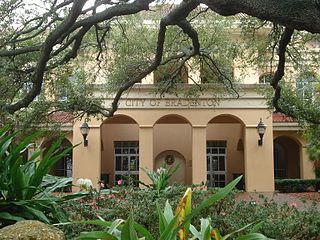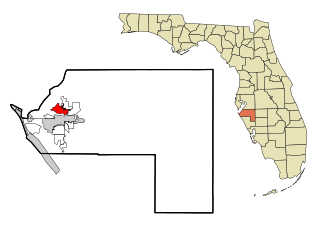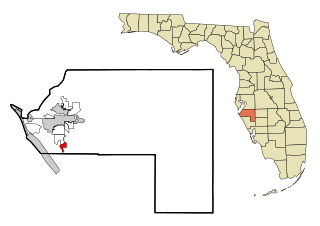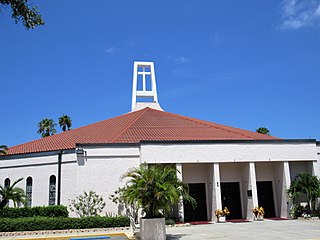Related Research Articles

Manatee County is a county in the U.S. state of Florida. As of the 2020 US Census, the population was 399,710. Manatee County is part of the Bradenton-Sarasota-Venice, Florida Metropolitan Statistical Area. Its county seat and largest city is Bradenton. The county was created in 1855 and named for the Florida manatee, Florida's official marine mammal. Features of Manatee County include access to the southern part of the Tampa Bay estuary, the Sunshine Skyway Bridge, and the Manatee River.

Sarasota County is a county located in Southwest Florida. At the 2020 US census, the population was 434,006. Its county seat is Sarasota and its largest city is North Port. Sarasota County is part of the North Port–Sarasota–Bradenton, FL metropolitan statistical area.

Bradenton is a city in and the county seat of Manatee County, Florida, United States. As of the 2020 census, the city's population is 55,698. Downtown Manatee is along the Manatee River and includes the Bradenton Riverwalk. Downtown Bradenton is also home to the Bishop Museum of Science and Nature.

Longboat Key is a town in Manatee and Sarasota counties along the central west coast of the U.S. state of Florida, located on and coterminous with the barrier island of the same name. Longboat Key is south of Anna Maria Island, between Sarasota Bay and the Gulf of Mexico. It is almost equally divided between the Manatee and Sarasota counties. The town of Longboat Key was incorporated in 1955 and is part of the Bradenton-Sarasota-Venice, Florida Metropolitan Statistical Area. The town's population was 6,888 at the 2010 census, which decreased from 7,603 at the 2000 census. It increased to 7,505 in the 2020 census.

Palmetto is a city in Manatee County, Florida, United States. As of the 2020 census, the population was listed as 13,323. It is part of the North Port–Sarasota–Bradenton metropolitan statistical area.

Whitfield, also known as Whitfield Estates, is an unincorporated community and census-designated place (CDP) in Manatee County, Florida, United States. As of the 2020 census it had a population of 2,989. It is part of the North Port–Sarasota–Bradenton Metropolitan Statistical Area. It receives its mail from the Sarasota post office located in Sarasota County.

Sarasota is a city in and the county seat of Sarasota County, Florida, United States. It is located in Southwest Florida, the southern end of the Greater Tampa Bay Area, and north of Fort Myers and Punta Gorda. Its official limits include Sarasota Bay and several barrier islands between the bay and the Gulf of Mexico. Sarasota is a principal city of the Sarasota metropolitan area. According to the 2020 U.S. census, Sarasota had a population of 54,842.

Sarasota–Bradenton International Airport is located within three jurisdictions: Sarasota County, the city limits of Sarasota, and Manatee County, in the U.S. state of Florida. Owned by the Sarasota Manatee Airport Authority, it is 3 miles (4.8 km) north of Downtown Sarasota and 6 miles (9.7 km) south of Bradenton.

The Sarasota Reds were a professional minor league baseball team, located in Sarasota, Florida, as a member of the Florida State League. The team originally started play in Sarasota as the Sarasota White Sox in 1989. They remained in the city for the next 21 seasons, going through a series of name changes due to their affiliation changes. They were known as the White Sox from 1989–1993, as the Sarasota Red Sox from 1994–2004, and the Reds from 2004–2009. In Sarasota, the team played in Payne Park (1989) and then Ed Smith Stadium (1990–2009). They won two division championships, in 1989 and 1992, and made playoff appearances in 1989, 1991, 1992, 1994, and 2007.
State College of Florida, Manatee–Sarasota (SCF) is a public college with campuses in the Manatee and Sarasota counties of Florida. Part of the Florida College System, it is designated a "state college" because it offers a greater number of bachelor's degrees than community colleges. SCF is accredited by the Southern Association of Colleges and Schools. Founded in 1957 as Manatee Junior College, it was known as Manatee Community College from 1985 to 2009.

The Diocese of Venice in Florida is a Latin Church ecclesiastical territory–or diocese, of the Catholic Church in southwest Florida in the United States. It was founded on June 16, 1984.

Anna Maria Island, is a barrier island on the coast of Manatee County, Florida, in the United States. It is bounded on the west by the Gulf of Mexico, on the south by Longboat Pass, on the east by Anna Maria Sound, and on the north by Tampa Bay. Anna Maria Island is approximately 7 miles (11 km) long north to south.

The Episcopal Diocese of Southwest Florida is a diocese of the Episcopal Church in the United States of America (ECUSA) in Florida which extends from Marco Island on the south, to Brooksville on the north, and inland to Plant City, Arcadia and LaBelle on the east. As part of the ECUSA, the diocese is a constituent member of the worldwide Anglican Communion.
Lakewood Ranch is a planned community and census-designated place (CDP) in southeastern Manatee County and northeastern Sarasota County, Florida, United States, consisting of approximately 31,000 acres (13,000 ha). It is part of the North Port-Bradenton-Sarasota, Florida Metropolitan Statistical Area. According to the 2020 census, the CDP had a population of 34,877.
Myakka City is an unincorporated community in southeastern Manatee County, Florida, United States. It lies along State Road 70 near the city of Bradenton, the county seat of Manatee County. Its elevation is 43 feet (13 m), and it is located at 27°20′59″N82°9′41″W. Although Myakka is unincorporated, it has a post office, with the ZIP code of 34251; the ZCTA for ZIP code 34251 had a population of 6,351 at the 2010 census. up from 4,239 in 2000.
Friends of Seagate Inc. was founded in the late 1980s by Kafi Benz as a 501(c)(3) nonprofit organization in Sarasota, Florida. The historic preservation group lead local efforts protect historic property in the Sarasota-Bradenton area from commercial development. The group later expanded its scope to include environmental conservation. Its most notable project was the preservation of Seagate, the former home of Cincinnati, Ohio, industrialist Powel Crosley Jr. and his wife, Gwendolyn, and its later owners, Mabel and Freeman Horton. In 2002 the organization tried to secure Rus-in- Ur'be, an undeveloped parcel of land in the center of the Indian Beach Sapphire Shores neighborhood, as a local park; however, as of 2014, real estate developers intend to build condominium units at the site.
Julie Catherine Laible was a professor at University of Alabama killed by a large rock thrown at her car from an overpass while she was driving along Interstate 75 in Manatee County, Florida, on March 28, 1999.
The earliest known identification of the area known today as Sarasota, Florida, was identified on a sheepskin Spanish map from 1763 with the word "Zarazote" written over the location of present-day Sarasota and Bradenton. The municipal government of Sarasota was established when it was incorporated as a town in 1902. Incorporation under the city form of government followed in the next decade. In 1921, Sarasota County was formed out of Manatee County, with Sarasota city serving as the county seat.
Angola was a prosperous community of up to 750 maroons that existed in Florida from 1812 until Florida became a U.S. territory in 1821, at which point it was destroyed. The location was along the Manatee River in Bradenton, Florida, near Manatee Mineral Springs Park. The exact location is expansive, ranging from where the Braden River meets the Manatee River down to Sarasota Bay; archaeological research focuses on the Manatee Mineral Spring—a source of fresh water and later the location of the Village of Manatee two decades after the destruction of the maroon community. Archaeological evidence has been found and the archaeology report by Uzi Baram is on file with the Florida Division of Historical Resources of the Florida Department of State.

Seagate, also known as the Bay Club, is located along Sarasota Bay in Manatee County, Florida, and was the former winter estate of Powel Crosley Jr., a noted Cincinnati, Ohio, industrialist and entrepreneur. Crosley had the 11,000-square-foot (1,000 m2), Mediterranean Revival-style home built in 1929 for his wife, Gwendolyn, on 45-acre (18-hectare) of land along Sarasota Bay that was platted in 1925 for a failed subdivision. New York architect George Albree Freeman Jr. designed the home; Ivo A. de Minicis, a Tampa, Florida, architect, drafted the plans; and Paul W. Bergmann, a Sarasota contractor, reportedly built the two-and-a-half-story, cast-stone-and-stucco home in 135 days. Gwendolyn Crosley died at Seagate in 1939. After allowing the Army Air Corps to use the home for airmen who were training at a nearby airbase during World War II, Crosley sold the property in 1947. Freeman Horton and his wife, Mabel, bought it the following year. The Horton family lived on the estate from 1948 to 1977. The Campeau Corporation of America acquired the property in the early 1980s, intending to develop it into condominium units and use the residence serving as the development's clubhouse, but its plans failed. The Crosley home and 45 acres of adjacent property were formally added to the National Register of Historic Places on January 21, 1983.
References
- Burnett, Gene. "The Vigilantes of Sara Sota." In Florida's Past: People and Events That Shaped the State, Volume 3, 80-83. Sarasota: Pineapple Press, 1991.
- Favorite, Merab-Michal. "Sunday Favorites: The Sarasota Assassination Society, Part 1." The Bradenton Times, August 19, 2012.
- Favorite, Merab-Michal. "Sunday Favorites: The Sarasota Assassination Society, Part 3." The Bradenton Times, September 2, 2012.
- Matthews, Janet Snyder. “He Has Carried His Life in His Hands": The "Sarasota Assassination Society" of 1884. The Florida Historical Quarterly 58, no. 1 (Jul. 1979): 1-21.
- Matthews, Janet Snyder. Edge of Wilderness: A Settlement History of Manatee River and Sarasota Bay, 1528-1885. Tulsa: Caprine Press, 1983.
- "An Assassination Society." The New York Times, February 2, 1885.